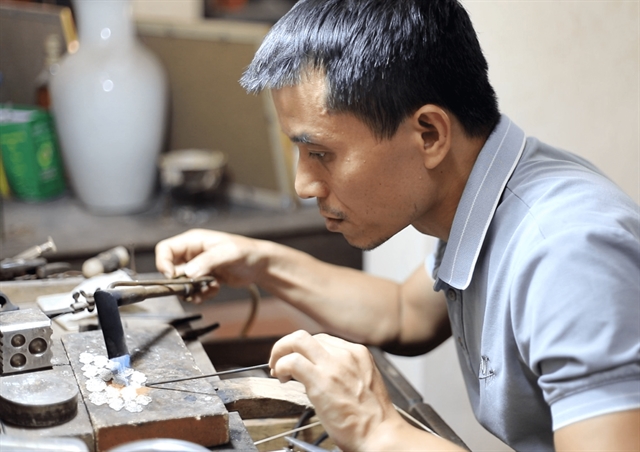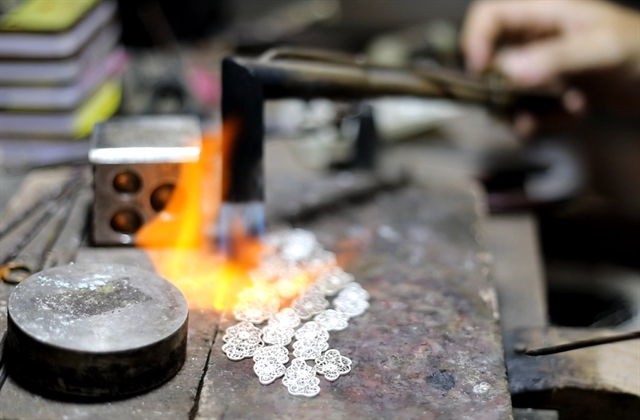 Sunday/Weekend
Sunday/Weekend

By Trần Khánh An & Hà Linh
In the hustle and bustle of a southern district of Hà Nội, nestles a silversmiths inside a tranquil temple dedicated to the founders of the ancient craft.
Currently, the workshop has 10 workers, mostly young, and is owned by artisan Quách Phan Tuấn Anh.
 |
| Artisan Quách Phan Tuấn Anh, 42, is the owner of a workshop located inside the temple dedicated to the founders of silversmithing in Định Công Village. VNS Photo Đoàn Tùng. |
Holding a pair of tweezers in his right hand, Anh skilfully attaches a cloud design on a silver box. All around him, other silversmiths sit diligently perfecting their works of art, working with the precious metal all day long.
The story of Định Công silvercraft village began in the sixth century, before the Lý Dynasty, when three brothers from the Trần family went to Định Công Village and taught the villagers to make silver jewellery.
Passing it down from generation to generation, the village became one of the four most elite craft villages in Thăng Long Citadel. Định Công silversmiths created intricate objects as altar items and fine jewellery for centuries.
Renowned for its rich tradition of high craftsmanship, the village has thrived for 1,500 years. However, it now faces the challenge of disappearing.
There are only two families in the village still engaging in the craft, including the workshop of artisan Anh and the other owned by artisan Quách Văn Hiểu.
Anh said that urbanisation was one of the reasons why Định Công Village is under threat.
“Urbanisation in Định Công Village has restricted the space for the trade. Currently, many silversmiths have to receive small orders to work at home. They gradually lose interest in the craft and find other jobs. These days, many residents in Định Công do not even know the existence of silvercraft in the village,” Anh said.
In addition, with changes in mindsets and lifestyles, young people in Định Công have chosen other careers and often lost touch with their forebears' traditions. They have more job opportunities with higher income without having to spend more time and effort training as silversmiths.
Even Anh was set to reject the traditional craft from his father at one point.
 |
| A miniature schooner crafted by siversmiths in the village of Định Công. VNS Photo Đoàn Tùng. |
Passing down
"I grew up watching my father making silver jewellery every day. I also helped him do some simple jobs,” Anh said.
“My father has always been an inspirational role model for me. As a wounded soldier, after the war, he intended to quit silvercraft, but he continued to take the trade to make a living to bring up his three children.”
When Anh grew up, he initially insisted on not following his family's craft. It was not until he graduated from the National Economics University that he changed his mind.
Anh told Việt Nam News about the moment he truly realised the potential of silvercraft.
“At that time, many customers came to order from my father in large quantities. However, he couldn't manage to turn out such a large number of goods on his own.”
Additionally, his father, artisan Quách Văn Trường, was then the only master artisan left in the village.
“Định Công craft village has survived and thrived over the centuries. If my village’s silvercraft disappears in my generation, I would feel guilty and responsible for that,” Anh said.
After graduating, he decided to become a silversmith and learned everything again from scratch. Along with his father, he called on the other artisans in the village to return to the craft and has maintained his workshop for 20 years.
 |
| A silversmith patiently solders thousands of tiny silver granules onto metal bases – a process that requires a high level of patience, caution, and attention to detail. VNS Photo Đoàn Tùng. |
Exquisite craftsmanship
“Đậu bạc” in Vietnamese means the technique of silver wire drawing and arranging into shapes to form different patterns to create a silver product.
The work begins with melting silver into ingots. The worker must make sure that these bars are even and free from any clumps or irregularities, preventing any unwanted breaks.
Next, the flat silver bars are pulled into silver threads. The size of the threads varies, with the smallest just 0.3 millimetres. With these silver threads in hand, workers carefully shape them based on drawings. This stage requires a keen eye for details and a steady hand to bring the design to life.
According to Đạt, a skilled craftsman at Anh’s workshop, welding is the most challenging step in the entire process.
“Excessive heat can distort the shape of the products, while insufficient heat can result in loose joints. Therefore, the workers must have great patience and take care to achieve the best results.”
Due to the level of complexity and details required, some products take a considerable amount of time to finish.
“Items like small image frames or simple alphabet characters can be finished in one or two days, while the more complex products such as miniature animals or objects may require a year or more to be meticulously crafted,” Đạt said.
 |
| A silversmith must constantly adjust the heat to ensure a perfect bond between the silver threads. VNS Photo Đoàn Tùng. |
Handing on the torch
Anh’s workshop has expanded production to meet the growing demand, and the number of orders is enough for Anh and his staff to live comfortably. However, the artisan has greater goals in mind.
To preserve and expand the Định Công silvercraft, he believes it is critical to train a new generation of silversmiths, and build the reputation of its products.
"To develop the craft village, Định Công needs more young workers with high skills and great patience. That is why I offer free training to locals, and even those from other places," Anh said.
He spends a tremendous amount of time imparting his skills to young workers. What they are inheriting is not only a working skill but also a culture.
Nguyễn Nhật Thành, who is only 18 years old, has learnt silversmithing for three years. He is not a Định Công native but from a neighbouring district.
“When I was 15, I had no intention to have a high education, and no idea what to do with my future. Uncle Anh took me to his workshop and taught me the craft. I am suitable for this work, I think,” Thành said.
Anh made various products with sophisticated designs to participate in fairs, exhibitions, and handicraft competitions. He won first place twice in 2020 and 2022 in the Việt Nam national handicraft competition.
 |
| Besides fine jewellery, Anh has developed a line of silver paintings and designed silver samples following customer requests. VNS Photo Đoàn Tùng. |
Crafting many works of art not only highlights the skill of Định Công silversmiths but also brings Anh happiness in his creativity.
“When I finish a single product, I am so happy that I have surpassed myself. There are no limits to creativity in this craft, but craftsmen will always need motivation to be satisfied with their job and create more,” Anh said.
Định Công artisans are also seeking the authorities' support to have an exclusive space for the village to preserve their traditional craft. They also hope to have a space to display and promote their products, as well as welcome foreign visitors to experience silver jewellery making.
“My journey has just begun, and challenges are still ahead. However, I believe that Định Công silvercraft will come alive once again.” VNS




